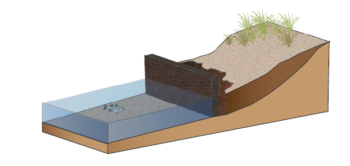Learn about the benefits of living/ natural shoreline here and check out our progress on the Suffolk County Marine Environmental Learning Center Living Shoreline project in Southold.

Living shorelines use plants or other natural elements to stabilize coastlines. A comparison of living and hardened shorelines. Image from NOAA.
Faced with rising sea levels and the potential for stronger, more frequent storms as a result of global climate change, many property owners on the east end of Long Island have been installing bulkheads, sea walls, and other hard shoreline structures to protect their property. Unfortunately, these hard structures can have negative consequences for the environment and wildlife, and can worsen coastal erosion and flooding, putting local properties at risk.
Hardened Shorelines

When hard shoreline structures are hit by waves, energy is reflected further down the shoreline disrupting natural sediment movement patterns and altering the shape of the coast. This process can alter the erosion and deposition patterns of sandy sediments, ultimately leading to shoreline destabilization. This destabilization can create problems for surrounding areas and may encourage nearby landowners to install hard structures along their property as well, further exacerbating the problem.
This “domino effect” of replacing natural shoreline with hard structures can result in the loss of important coastal habitats, including wetlands, beaches, and eelgrass beds. Habitat loss can negatively impact the fishing and tourism industries, as well as the wildlife that rely on these areas for feeding, reproduction, or nursery grounds.
Click the link below for full article.
